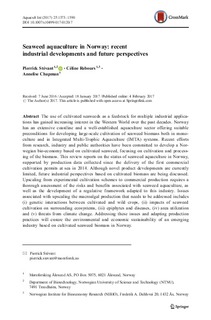| dc.contributor.author | Stévant, Pierrick Francois Denis | |
| dc.contributor.author | Rebours, Celine | |
| dc.contributor.author | Chapman, Annelise Sabine | |
| dc.date.accessioned | 2018-04-13T08:28:03Z | |
| dc.date.available | 2018-04-13T08:28:03Z | |
| dc.date.created | 2017-02-06T10:07:07Z | |
| dc.date.issued | 2017 | |
| dc.identifier.citation | Aquaculture International. 2017, 25 (4), 1373-1390. | nb_NO |
| dc.identifier.issn | 0967-6120 | |
| dc.identifier.uri | http://hdl.handle.net/11250/2494006 | |
| dc.description.abstract | The use of cultivated seaweeds as a feedstock for multiple industrial applications has gained increasing interest in the Western World over the past decades. Norway has an extensive coastline and a well-established aquaculture sector offering suitable preconditions for developing large-scale cultivation of seaweed biomass both in monoculture and in Integrated Multi-Trophic Aquaculture (IMTA) systems. Recent efforts from research, industry and public authorities have been committed to develop a Norwegian bio-economy based on cultivated seaweed, focusing on cultivation and processing of the biomass. This review reports on the status of seaweed aquaculture in Norway, supported by production data collected since the delivery of the first commercial cultivation permits at sea in 2014. Although novel product developments are currently limited, future industrial perspectives based on cultivated biomass are being discussed. Upscaling from experimental cultivation schemes to commercial production requires a thorough assessment of the risks and benefits associated with seaweed aquaculture, as well as the development of a regulative framework adapted to this industry. Issues associated with upscaling the macroalgal production that needs to be addressed includes (i) genetic interactions between cultivated and wild crops, (ii) impacts of seaweed cultivation on surrounding ecosystems, (iii) epiphytes and diseases, (iv) area utilization and (v) threats from climate change. Addressing these issues and adapting production practices will ensure the environmental and economic sustainability of an emerging industry based on cultivated seaweed biomass in Norway. | nb_NO |
| dc.language.iso | eng | nb_NO |
| dc.publisher | Springer Verlag | nb_NO |
| dc.rights | Navngivelse 4.0 Internasjonal | * |
| dc.rights.uri | http://creativecommons.org/licenses/by/4.0/deed.no | * |
| dc.title | Seaweed aquaculture in Norway: recent industrial developments and future perspectives | nb_NO |
| dc.type | Journal article | nb_NO |
| dc.type | Peer reviewed | nb_NO |
| dc.description.version | publishedVersion | nb_NO |
| dc.source.pagenumber | 1373-1390 | nb_NO |
| dc.source.volume | 25 | nb_NO |
| dc.source.journal | Aquaculture International | nb_NO |
| dc.source.issue | 4 | nb_NO |
| dc.identifier.doi | 10.1007/s10499-017-0120-7 | |
| dc.identifier.cristin | 1447248 | |
| dc.relation.project | Norges forskningsråd: 244244 | nb_NO |
| dc.description.localcode | © The Author(s) 2017. Open Access. This article is distributed under the terms of the Creative Commons Attribution 4.0 International License (http://creativecommons.org/licenses/by/4.0/) | nb_NO |
| cristin.unitcode | 194,66,15,0 | |
| cristin.unitname | Institutt for bioteknologi og matvitenskap | |
| cristin.ispublished | true | |
| cristin.fulltext | postprint | |
| cristin.qualitycode | 1 | |

